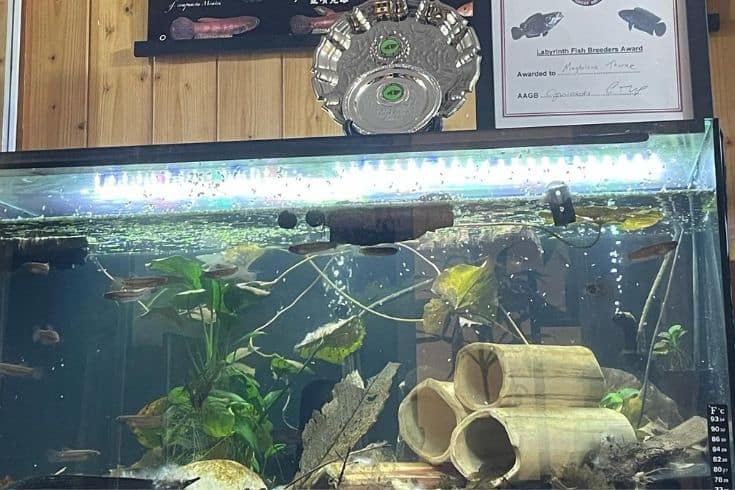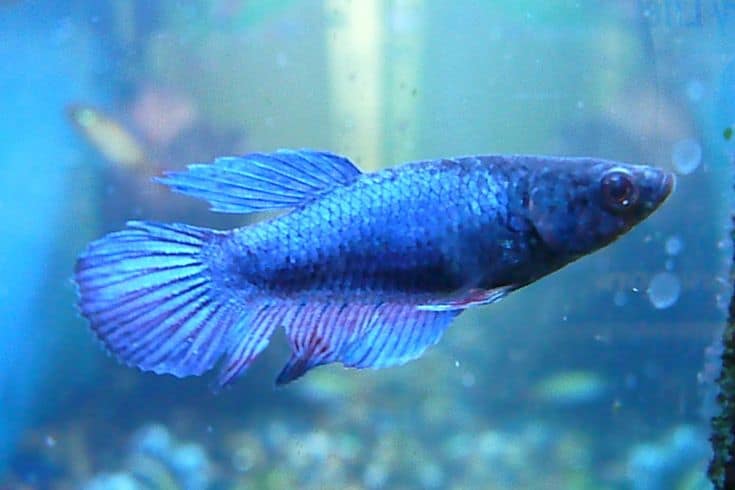Betta fish are one of the most popular pets in the world. Originating from Thailand, they are beautiful, unique, and relatively easy to care for.
Baby bettas are even more fragile than adult bettas and require extra care and attention. This guide will cover everything you need to know about baby betta care, from what to feed them to how to keep them healthy.
Betta Fish Growth Chart
Before we get into the specifics of baby betta care, it’s important to understand how fast they grow. The average growth of betta fishes can be up to 2 inches (5 cm) in just a few months, so they require a lot of food and space.
Here is a growth chart to give you an idea of how big your fish will be at the different growth stages of their life:
- 1 month old: 0.5 inches (1.3 cm)
- 2 months old: 1 inch (2.5 cm)
- 3 months old: 1.5 inches (3.8 cm)
- 4 months old: 2 inches (5 cm)
As you can see, baby betta grows very quickly! This is why it’s important to have a large tank and plenty of food on hand. We will discuss below how to set up a proper tank for your baby betta fish.
Betta Fish Growth Stages
Bettas have three main growth stages: the egg, juvenile, and adult stages.
Egg Stage

The first stage of a baby betta’s life is spent within its egg. This stage lasts for about 3-5 days, during which the egg will hatch, and the baby betta will emerge. During this time, your unborn baby bettas obtain all their required nutrients from the yolk sac they are attached to. You can think of it as their food source and main source of hydration during this critical time.
To help ensure successful hatching, it is important to maintain the water temperature at around 80-86 degrees Fahrenheit (27-30 degrees Celsius). An aquarium heater, though not an absolute must, is highly recommended to help maintain a stable water temperature.
You will also want to make sure the water is clean and free of any contaminants. Not only will this allow your betta eggs to hatch successfully, but it will also help prevent any deformities or health problems in your baby betta fish. Clean water is one of the most important components of betta health, regardless of their life stage.
Juvenile Stage
The fry and juvenile stage is when your baby betta fish starts to grow and develop into an adult. This stage lasts for about 4-6 months, during which your betta will grow from 0.5 inches (1.3 cm) to 2 inches (5 cm). This is critical for your baby fish, as they are still very fragile and need extra care.

For most of the juvenile phase, betta fry can be kept together. However, as they start to grow larger, you will need to start separating them into their own tanks. This is because adult bettas are territorial and can become aggressive towards each other.
You will also need to start changing the water more frequently during this stage. Juvenile bettas produce a lot of waste, so keeping the water clean and fresh is important. Dirty water will wreak havoc on their delicate immune system, causing problems like swim bladder disease. Keeping your tank clean will keep your fish healthy for years to come.
Adult Stage
The adult stage is when your betta fish has reached its full size and is fully grown. This typically happens around the 6-month mark, but can vary depending on the individual fish. Once your betta fish has reached adulthood, you can start feeding them less often. Aim for 2-3 meals per week, rather than daily feedings.
At this juncture, you will also want to start slowly acclimating your betta to a new tank if you plan on moving them. Adult bettas are much less fragile than their juvenile counterparts but still need time to adjust to new surroundings.
Regular water changes remain important even during the adult stage. You may also want to consider several other tank accessories, such as an air pump, dedicated filter, and tank décor. These little additions can go a long way in helping your betta feel at home and comfortable in their new environment.
Baby Betta – General Care Tips
Now that you know better what to expect during each stage of a baby betta’s life, let’s go over some general care tips to help raise healthy and happy fish.
- Betta fishes are very sensitive to changes in water quality. Be sure to do frequent water changes to keep the water clean.
- They are also very sensitive to light. Keep the tank in a dimly lit room to prevent them from getting stressed.
- They are very prone to diseases. Be sure to quarantine any new fish before adding them to the tank.
- It is best to use live food when feeding betta fishes. This will give them the best chance of survival.
- Betta fishes are very delicate and can be easily injured. Be sure to handle them with care.
Feeding Guide
The general tips we’ve gone over so far will help you take care of your baby betta fish in the best way possible. But what about feeding them? What kind of food do baby bettas need, and how often should they eat? Let’s go over the basics of feeding your baby betta fish so you can ensure they’re getting all the nutrients they need to grow and thrive.
When it comes to food, baby bettas are not that different from adult bettas. They still need a diet that consists of both protein and vegetables. Liquid fry food and mosquito larvae are fantastic options, but they can be hard to find at most fish stores. Dry foods, frozen brine shrimp, or tubifex worms will work just as well, as long as you take special care and make sure they’re the right size.
Note that because your baby bettas are growing and developing, they will need to eat more often than adults.The best way to feed your baby betta is by giving them small meals several times a day, rather than one large meal. This will help ensure they get all the nutrients they need without overfeeding them.
Proper nutrition is vital to basic betta care, especially when your pets are only several weeks of age. We hope these pointers have given you an idea of how to keep your bettas properly fed, regardless of their life stage!
How To Set Up A Tank For Baby Bettas
Now that you know all about feeding baby betta fish, it’s time to get out there and start setting up their tank! Here are a few things to keep in mind when setting up a tank for your fry:

- The first thing you’ll need to do is choose the right size tank. Baby bettas are very small, so they won’t need a lot of space. A 5-gallon tank is typically sufficient for a school of fry.
- Next, you’ll need to fill the tank with water. Be sure to use a water conditioner to remove any chlorine or other harmful chemicals from the water. Then, cycle the tank using a fishless cycle method before adding your fry.
- Once the tank is set up and cycled, you can start adding plants and decorations. Baby bettas like to have hiding places, so be sure to create lots of hiding spaces that will put them at ease and make them feel right at home.
- Finally, you’ll need to add an adjustable heater to the tank. Baby bettas are tropical fish and require warm water to survive. Keep the tank temperature between 78-82 degrees Fahrenheit.
- Now, your tank is all set up and ready for your fry! Introduce them to their new habitat slowly by acclimating them over a period of an hour or so. Then, watch and enjoy as they start exploring their new home!
Baby bettas are adorable with a ton of personality, making great first pets for kids and adults alike. This tank setup will ensure they have everything they need to thrive in their new home!
FAQs
How Many Eggs Do Betta Fish Lay?

Betta fish typically lay 3 to 4 days after mating. Males are usually more aggressive than females during spawning, and may even eat the eggs if given the chance. Removing the male betta from the tank after spawning is important to ensure that the fish has a chance to survive.
You can expect your betta fish to hatch within 3 to 4 days. It is important to keep the tank clean and the water quality high during this time. Baby bettas are very sensitive to changes in their environment, so it is important to keep a close eye on them.
Once your baby bettas have hatched, they will need to be fed a diet of live or frozen foods. Baby brine shrimp, daphnia, and micro worms such as white, grindal, black, etc. are all good options. It is also important to provide plenty of hiding places for your betta fish, as they are very vulnerable to predators.
Your baby betta will grow into a healthy and happy adult betta fish with proper care.
Do Baby Bettas Change Color As They Grow?
As they grow, baby bettas will begin to change color. This is normal and should not be cause for concern. Baby betta fish will change color from around 4-6 months of age, whereas pet store bettas will change at six months old as they are not fully developed in color or fin growth until this age.

Male bettas are often sold when they reach 9-12 months of age since their stronger colors and plumage take longer to develop. Female bettas will not usually have as much coloration as male betta fish, which can help tell them apart from the more aggressive males.
Some baby bettas will change color more dramatically than others, but all will undergo some kind of color change as they mature. Once they reach adulthood, their color will be relatively stable.
Can Baby Bettas Live Together?
Yes, baby bettas can live together. However, they may become aggressive as they mature and need to be separated into their tanks. As a rule of thumb, you can keep baby fry together until they reach 4-6 months of age. After that, they should be separated into their own tanks to prevent aggression and fighting.
Of course, female bettas can be kept together, but they may still become aggressive towards each other as they mature. It is best to keep an eye on them and be prepared to separate them if necessary. Preempt aggression by providing plenty of hiding places and using a larger tank (at least 10 gallons.)
How Long Do Betta Fish Live?

Betta fishes typically have a lifespan of 2-5 years, though some may live longer with proper care.
Factors such as diet, tank size, and tank conditions such as water quality, water temperature, and water parameters can all impact a betta’s lifespan and growth. Your betta fish can enjoy a long and happy life with proper care.
The Takeaway
Whether your baby bettas are the product of a carefully planned breeding program or a happy accident, they are sure to bring you joy. Baby bettas are beautiful and unique creatures with their own personalities. With proper care, your baby bettas will grow into healthy and happy adult fish that you can enjoy for years to come.
We hope this guide has been helpful in teaching you about baby bettas. Please feel free to share it with other betta enthusiasts!
Happy fish keeping!
